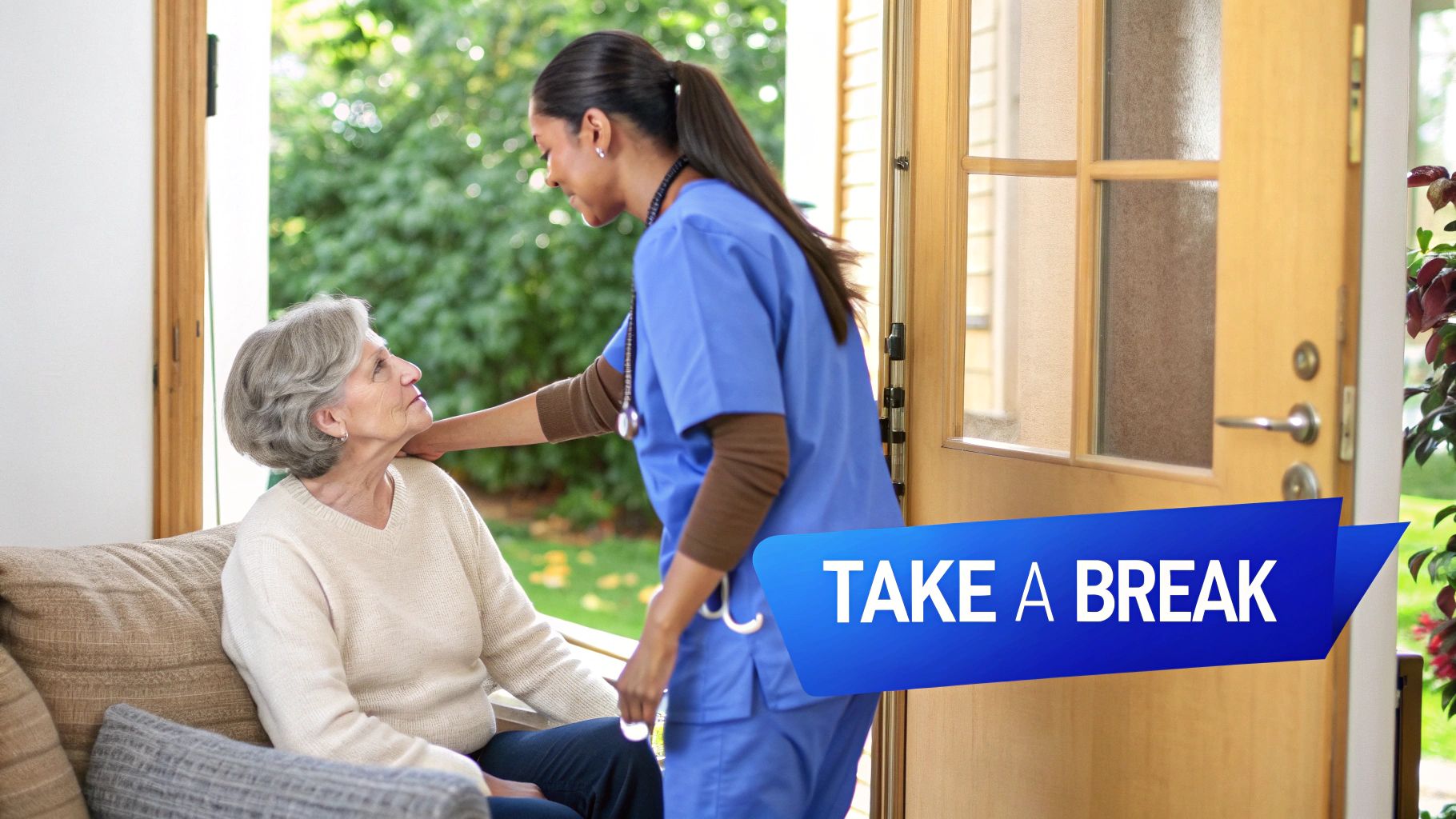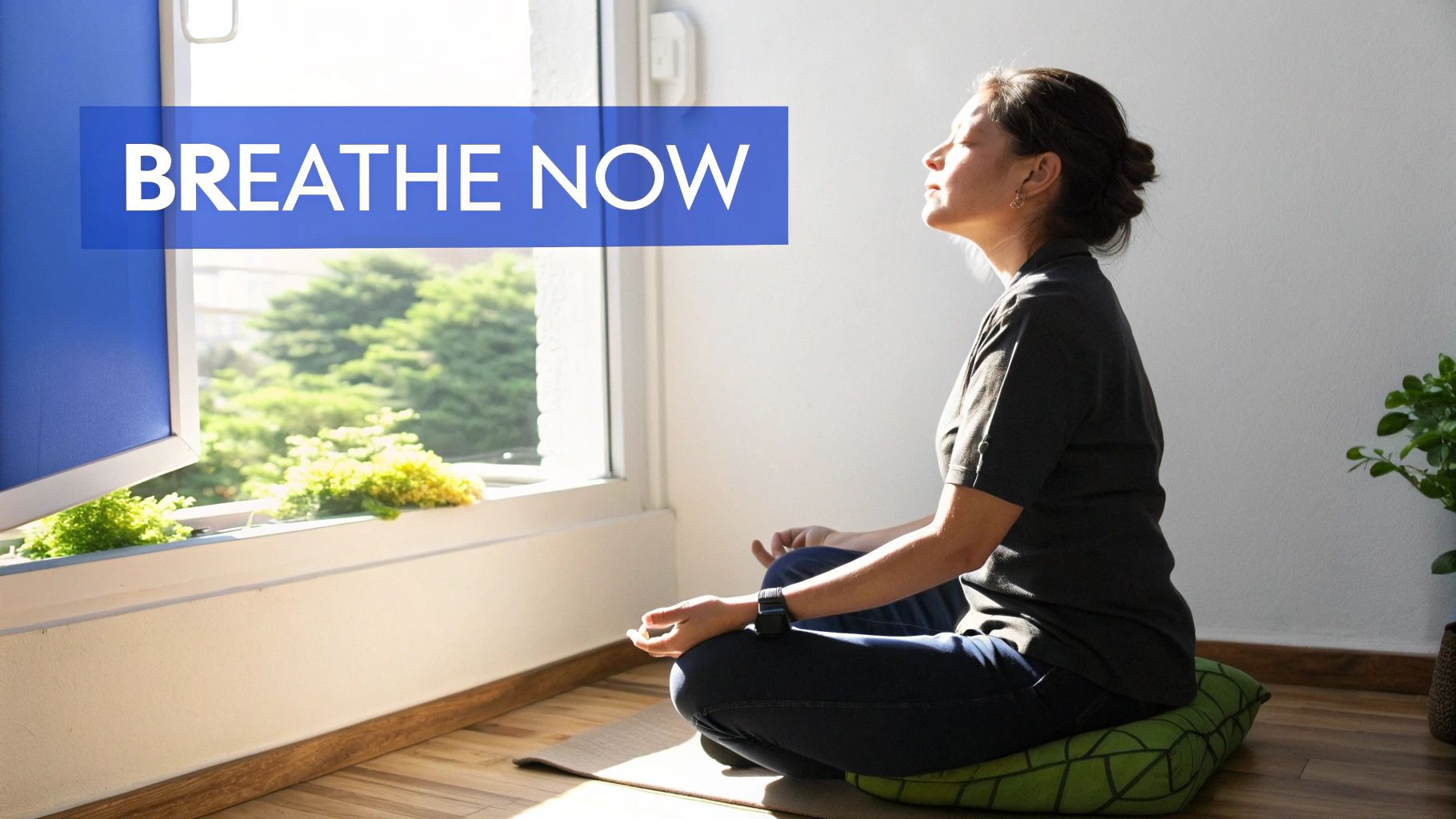Being a caregiver is a profound act of love and dedication, but it often comes at a high personal cost. The constant physical, emotional, and mental demands can lead to burnout, chronic stress, and a significant decline in your own health. This guide is built on a fundamental truth: effective self care for caregivers is not a luxury; it is a non-negotiable part of providing sustainable, compassionate support to a loved one.
Neglecting your own needs does not make you a better caregiver. In reality, it jeopardizes your ability to show up fully and effectively for the person who depends on you long-term. Sustainable caregiving requires a resilient, healthy, and supported caregiver.
In the following sections, we will explore 10 specific, actionable strategies designed to replenish your energy, protect your well-being, and empower you to navigate your demanding role with strength. From leveraging respite care and setting firm boundaries to prioritizing your own health appointments, each point offers practical steps you can implement immediately. Think of this not as another to-do list, but as a practical toolkit to help you prioritize your own health, one manageable step at a time.
1. Respite Care Services
Respite care is a vital form of support that provides temporary relief for primary caregivers. It involves bringing in a professional or trained individual to take over caregiving duties for a set period, allowing you to step away, rest, and recharge without worrying about your loved one's well-being. This is a cornerstone of effective self care for caregivers, as it directly prevents burnout by building scheduled breaks into your routine.

This service can range from a few hours a week to several days, depending on your needs. The goal is to give you a genuine break, whether you use the time for errands, appointments, socializing, or simply sleeping.
How to Implement Respite Care
Finding and integrating respite care can seem daunting, but starting small makes it manageable. Here are practical steps to get started:
- Explore Local Options: Begin by researching different types of services. Common examples include in-home care agencies providing four-hour breaks, adult day programs offering structured activities for 6-8 hours, and even weekend respite programs at community or senior centers.
- Start Gradually: To help your loved one adjust and to build your own trust, start with short respite periods. A two or three-hour session is a great way to test the waters with a new provider.
- Prepare a Caregiver's Guide: Create a detailed document with your loved one’s routine, medication schedule, emergency contacts, and preferences. This ensures consistency of care and gives you peace of mind.
- Plan Your Time: Intentionally decide how you will use your break. While it's tempting to fill it with chores, prioritize an activity that is truly restorative for you. You can find out more about the different types of respite care for caregivers here.
2. Mindfulness and Meditation Practice
Mindfulness and meditation are powerful tools that help caregivers manage the mental and emotional toll of their responsibilities. This practice involves focusing on present-moment awareness, which reduces the persistent anxiety and rumination that often accompany caregiving. Incorporating regular mindfulness is a crucial form of self care for caregivers, as it directly addresses stress and prevents emotional exhaustion by creating mental space between you and your demanding role.

The goal is not to stop your thoughts but to observe them without judgment, providing immediate relief during difficult moments and building long-term resilience. This can range from a dedicated 10-minute daily meditation to simple breathing exercises performed throughout the day.
How to Implement Mindfulness and Meditation
Integrating these practices into a packed caregiving schedule is achievable when you start small and remain consistent. Here are practical steps to begin:
- Start with Short Sessions: Aim for just five minutes a day. Use guided meditation apps like Calm or Headspace to ease into the practice without feeling overwhelmed by a longer time commitment.
- Establish a Routine: Practice at the same time each day to build a sustainable habit. Try meditating during a quiet moment, such as when your loved one is resting or engaged in an independent activity.
- Use Simple Techniques: When feeling stressed, pause and take three deep breaths. Another effective technique is a body scan meditation, where you mentally scan your body to identify and release areas of physical tension.
- Explore Different Formats: If sitting still is difficult, try walking meditation by focusing on the sensation of your feet on the ground. You can learn more about how these practices support caregiver mental health here.
3. Physical Exercise and Movement
Regular physical activity is a powerful tool for caregivers to combat stress, boost mood, and improve overall health. Engaging in consistent movement releases endorphins, which act as natural mood elevators, and helps mitigate the physical and mental strain of caregiving. This form of self care for caregivers is not about intensive training; it's about integrating sustainable activity into your routine to build resilience.

This can be as simple as a daily walk, an online yoga class during your loved one's nap, or even chair exercises if mobility is a concern. The goal is to move your body in a way that feels good and reduces tension, making you a more grounded and energized caregiver.
How to Implement Physical Exercise
Fitting exercise into a demanding caregiving schedule requires intentional planning. Here are practical steps to make it a consistent part of your life:
- Start Small and Build: Don't aim for an hour-long workout right away. Begin with 10-15 minute increments, such as a short walk around the block or a quick stretching session. Even small bursts of activity provide significant benefits.
- Schedule It Like an Appointment: Block out time for exercise in your calendar. Treating it as a non-negotiable commitment increases the likelihood you will follow through, even on difficult days.
- Find Activities You Enjoy: Consistency is easier when you enjoy the activity. Explore options like dancing, gardening, swimming, or joining a local walking group to make fitness a source of joy rather than a chore.
- Involve Your Loved One: When possible, exercise together. A gentle walk or chair yoga can be a shared activity that benefits both of you. You can find helpful routines and guidance on exercises that improve balance and strength here.
4. Social Connection and Support Groups
Caregiving can be profoundly isolating, making social connection and support groups a critical tool for emotional survival. These groups provide a safe space to share experiences, gain practical advice, and receive validation from peers who genuinely understand the unique challenges you face. This form of peer support is an essential element of self care for caregivers, as it directly combats loneliness and builds emotional resilience.

Whether online or in-person, these communities remind you that you are not alone in your journey. They offer a powerful combination of empathy and shared knowledge, helping to reduce stress and improve your overall mental well-being.
How to Implement Social Connection
Finding the right community can significantly improve your caregiving experience. Here are practical steps to connect with others:
- Explore Different Formats: Look into groups tailored to your situation. Organizations like the Alzheimer's Association offer specialized support, while online forums like Reddit's r/Caregivers provide 24/7 access. You can also find local chapters through the Caregiver Action Network.
- Give It a Fair Chance: Finding the right fit takes time. Commit to attending at least three meetings before deciding if a particular group is right for you. The dynamic can change with each session.
- Schedule It Like an Appointment: Treat your support group meeting as a non-negotiable part of your schedule. Block it off in your calendar to ensure you prioritize this crucial self-care activity.
- Engage Authentically: Be open and honest about your struggles. Sharing your story not only helps you process your emotions but also encourages others to do the same, creating a stronger, more supportive environment for everyone.
5. Boundary Setting and Saying No
Establishing clear boundaries is a powerful act of self care for caregivers, helping you protect your energy, prevent resentment, and maintain a healthy balance. It involves learning to say "no" to additional demands from family, friends, or even the care recipient without feeling guilt. This practice ensures you can continue providing compassionate care without sacrificing your own well-being.
Boundaries are not walls to push people away; they are guidelines that protect your physical and emotional resources. For example, setting visiting hours prevents unexpected interruptions, while declining unhelpful "assistance" from relatives preserves your established routine and reduces stress.
How to Implement Boundary Setting
Learning to set and maintain boundaries is a skill that strengthens over time. Here are actionable steps to start protecting your personal resources:
- Start Small and Be Specific: Begin with a low-stakes boundary. For example, state that you will not answer non-urgent calls during your one-hour dinner break. This builds confidence for more significant conversations.
- Use "I" Statements: Frame your needs assertively but not aggressively. Instead of saying, "You can't just drop by," try, "I need at least 24 hours' notice before visits to manage our schedule effectively."
- Prepare Your Responses: Anticipate situations where your boundaries might be challenged. Have a few simple, firm phrases ready, such as, "I appreciate the offer, but that doesn't work for me right now," or "I'm not able to take that on."
- Don't Over-Explain: You do not need to provide a lengthy justification for your boundaries. A simple "no" or a brief explanation is sufficient. Apologizing or over-explaining can weaken your position and invite negotiation.
6. Professional Mental Health Support and Counseling
Professional mental health support involves working with licensed therapists, counselors, or psychologists to process emotions, develop coping strategies, and address depression, anxiety, or trauma linked to caregiving. This is a vital component of self care for caregivers, as it offers structured guidance and an objective space to explore stressors you face every day.
This support can include weekly one-on-one cognitive-behavioral therapy for caregiver anxiety, family therapy sessions to resolve conflicts, crisis counseling after acute stress events, grief counseling as you prepare for end-of-life care, or telehealth therapy during your loved one’s nap time. The goal is to equip you with practical tools, boost emotional resilience, and prevent burnout before it escalates.
How to Implement Professional Mental Health Support and Counseling
- Ask your primary care doctor for therapist referrals who specialize in caregiver issues
- Check insurance coverage and focus on in-network providers to reduce out-of-pocket costs
- Use directories like Psychology Today or TherapyDen to filter by caregiver experience
- Interview potential therapists about their approach, availability, and success with caregiver clients
- Be transparent about scheduling needs—consider evening or telehealth sessions if daytime is difficult
- Explore group therapy programs for peer support and lower fees
- Utilize an Employee Assistance Program (EAP) if offered by your workplace for free or discounted sessions
7. Nutrition and Hydration Mindfulness
Proper nutrition and hydration are the fuel that keeps a caregiver going, directly impacting energy levels, immune function, and mental clarity. Caregivers often grab whatever is quickest or skip meals altogether, leading to energy crashes and poor health. This form of self care for caregivers involves intentionally prioritizing your own dietary needs to sustain your physical and cognitive well-being.
Mindful eating and drinking prevent the depletion that comes from running on empty. A well-nourished body is better equipped to handle the stress and physical demands of caregiving, while staying hydrated improves focus and reduces fatigue.
How to Implement Nutrition and Hydration Mindfulness
Making small, consistent changes is the key to improving your diet without adding more stress to your plate. Here are practical ways to start:
- Batch Cook Simple Meals: Dedicate a few hours on a Sunday to prepare healthy meals for the week. Cook a large batch of rice, roast vegetables, and grill chicken or plant-based proteins that can be quickly assembled into different dishes.
- Keep Water Accessible: Carry a reusable water bottle with you at all times. Set a goal to refill it 4-6 times daily to ensure you stay properly hydrated without having to constantly think about it.
- Stock Nutrient-Dense Snacks: Have grab-and-go options readily available. Hard-boiled eggs, yogurt, nuts, and fruit provide a quick energy boost and are far better than processed snacks.
- Set Meal Reminders: It's easy to lose track of time when you're focused on someone else. Set alarms on your phone for breakfast, lunch, and dinner to create a consistent eating schedule and avoid skipping meals.
8. Sleep Hygiene and Adequate Rest
Establishing consistent sleep routines and prioritizing adequate rest is essential for caregiver resilience. Poor sleep exacerbates stress, emotional reactivity, and health problems, making sleep quality a non-negotiable self care for caregivers priority. By setting bedtime rituals and creating a sleep-friendly environment, you recharge mentally and physically, reducing burnout risk and improving daily performance.
This approach works by regulating your body clock, minimizing sleep disruptions, and promoting restorative rest. Examples include a 10 PM bedtime with a phone-free wind-down routine, using blackout curtains and white noise machines, napping 20–30 minutes during a care recipient’s rest, arranging night-shift respite care for full sleep nights, sharing overnight duties, or trying melatonin supplements with medical approval.
How to Implement Sleep Hygiene
- Set a Consistent Schedule: Maintain the same sleep and wake times even on weekends to stabilize your circadian rhythm.
- Create a Restful Environment: Keep your bedroom cool, dark, and quiet; consider solutions for sleep-disrupting back pain to relieve aches.
- Establish a Wind-down Routine: Dedicate 30 minutes to relaxation activities like reading or gentle stretching, and avoid screens for 30–60 minutes before bed.
- Limit Stimulants: Stop caffeine intake after 2 PM and avoid heavy meals close to bedtime.
- Leverage Respite Options: Arrange night-shift respite care or share overnight monitoring with family members to secure uninterrupted sleep.
- Practice Relaxation Techniques: Use progressive muscle relaxation or deep breathing to calm your mind before drifting off.
- Seek Professional Advice: Consult a doctor if sleep problems persist despite lifestyle changes and consider safe supplements under guidance.
9. Personal Time and Hobbies
Dedicating time to personal interests and hobbies is crucial for maintaining your identity outside of your caregiving role. This practice provides essential psychological restoration and prevents your sense of self from being completely consumed by care duties. Engaging in activities you love is a powerful form of self care for caregivers, offering an escape, a sense of accomplishment, and a connection to who you are as an individual.
This doesn't have to be a major time commitment. Even short, consistent periods dedicated to a hobby, such as reading, gardening, or crafting, can significantly reduce stress and improve your overall mood. The goal is to engage in something that feels restorative, not obligatory.
How to Implement Personal Time and Hobbies
Finding space for hobbies amidst a demanding schedule requires intention. Here are practical ways to integrate personal time into your routine:
- Schedule It Like an Appointment: Block out time for your hobby in your calendar, treating it as a non-negotiable commitment. Start with just 15-20 minute sessions if your schedule is tight.
- Choose Accessible Activities: Select hobbies that are easy to pick up and put down. Listening to an audiobook, sketching in a notepad, or practicing a musical instrument can fit into small windows of time.
- Create a Dedicated Space: Designate a small corner or area in your home for your hobby materials. Having everything ready to go reduces the effort needed to start.
- Combine with Other Self-Care: Pair your hobby time with another strategy, like respite care, to ensure you have uninterrupted, guilt-free time to fully immerse yourself in the activity.
10. Healthcare Maintenance and Preventive Care
Preventive care and regular checkups help caregivers maintain their own health and stamina. Prioritizing annual physical exams, age-appropriate screenings, vaccinations, and chronic disease management prevents small issues becoming emergencies. This proactive approach is a cornerstone of effective self care for caregivers because it preserves your capacity to provide consistent, high-quality support.
From dental cleanings twice a year to flu and COVID-19 vaccines each fall, a robust maintenance plan covers all bases. Managing existing conditions like hypertension or diabetes during routine mental health visits empowers you to catch side effects early. Combining preventive screenings such as mammograms, colonoscopies, and eye exams on a clear schedule ensures nothing slips through the cracks.
How to Implement Healthcare Maintenance and Preventive Care
- Schedule next appointments before leaving the doctor’s office
- Use respite care so you can attend medical visits stress-free
- Keep an up-to-date medication list and share it with each provider
- Track new symptoms in a health journal to discuss at visits
- Opt for telehealth follow-ups for simple check-ins or prescription renewals
- Check your insurance or Medicaid details for covered screenings
- Ask family members to help with transportation and reminders
- Block multiple specialist visits on the same day to reduce travel
- Review and update your healthcare proxy and advance directives annually
By embedding these steps into your calendar, you reinforce your own well-being and ensure you can care for others without sacrificing your health. For more resources, visit https://caringhandsnj.com/preventive-care.
Caregiver Self-Care: 10-Item Comparison
| Strategy / Service | Implementation Complexity 🔄 | Resource Requirements ⚡ | Expected Outcomes 📊⭐ | Ideal Use Cases | Quick Tip 💡 |
|---|---|---|---|---|---|
| Respite Care Services | High 🔄 — coordination, vetting providers | High ⚡ — cost, scheduling, travel | Strong 📊 — significant burnout reduction, reliable rest ⭐⭐⭐⭐ | When caregivers need uninterrupted breaks, errands, or travel | Start with short shifts; document care instructions |
| Mindfulness & Meditation Practice | Low 🔄 — simple routines, habit formation | Very low ⚡ — time, app or guide | Moderate–High 📊 — reduced stress, better emotion regulation ⭐⭐⭐ | Caregivers needing quick stress tools or during short free moments | Begin 5 min/day, use guided apps to build habit |
| Physical Exercise & Movement | Medium 🔄 — scheduling, adapting intensity | Low–Medium ⚡ — time, optional equipment | High 📊 — improved mood, energy, long-term health ⭐⭐⭐⭐ | When seeking mood boost, energy increase, or chronic disease prevention | Start 10–15 min sessions; combine with respite for consistency |
| Social Connection & Support Groups | Medium 🔄 — finding/attending groups | Low ⚡ — time, internet or travel | High 📊 — reduced isolation, practical advice ⭐⭐⭐⭐ | Caregivers needing peer validation, disease-specific guidance | Try several groups; attend 3 meetings before deciding |
| Boundary Setting & Saying No | Medium 🔄 — skill development, ongoing practice | Very low ⚡ — time for conversations | High 📊 — prevents overcommitment, preserves wellbeing ⭐⭐⭐⭐ | Caregivers overwhelmed by obligations or family pressure | Practice short "I" statements and set written care plans |
| Professional Mental Health Support | High 🔄 — finding therapist, scheduling | Medium–High ⚡ — cost, time, possible waitlists | High 📊 — targeted coping strategies, treat depression/anxiety ⭐⭐⭐⭐ | For complex emotional needs, trauma, or persistent distress | Ask for referrals; check telehealth and group therapy options |
| Nutrition & Hydration Mindfulness | Medium 🔄 — planning, prep, habit changes | Low–Medium ⚡ — groceries, time for prep | Moderate–High 📊 — sustained energy, improved cognition ⭐⭐⭐ | When energy dips or diet is neglected due to care demands | Batch-cook, keep water bottle nearby, prep nutrient-dense snacks |
| Sleep Hygiene & Adequate Rest | Medium 🔄 — routine establishment, environment | Low ⚡ — minor sleep aids, scheduling | High 📊 — better emotional regulation, cognitive function ⭐⭐⭐⭐ | Caregivers with disrupted sleep or chronic fatigue | Maintain consistent sleep schedule; use wind-down routine |
| Personal Time & Hobbies | Low–Medium 🔄 — scheduling, overcoming guilt | Low ⚡ — minimal cost/time depending on hobby | Moderate–High 📊 — identity restoration, reduced burnout ⭐⭐⭐ | When needing identity beyond caregiving and emotional recharge | Schedule short, regular hobby slots as non‑negotiable time |
| Healthcare Maintenance & Preventive Care | Medium 🔄 — scheduling, coordination of services | Medium ⚡ — appointments, possible costs | High 📊 — early detection, sustained caregiver health ⭐⭐⭐⭐ | For long-term caregiver capacity and chronic condition management | Schedule annual visits immediately; use telehealth where possible |
Integrating Self-Care into Your Daily Reality
Embarking on a journey of self-care is not about adding another overwhelming list of tasks to your already demanding schedule. Instead, it's about a fundamental shift in mindset. It's about recognizing that your well-being is not a luxury but a non-negotiable component of sustainable, compassionate caregiving. The strategies we've explored, from seeking professional respite care to setting firm boundaries, are not isolated fixes. They are interconnected tools designed to build a more resilient and balanced life.
True self care for caregivers is woven into the fabric of your daily existence through small, consistent, and intentional actions. It’s the five-minute meditation you practice while your loved one naps, the nutritious meal you prioritize for yourself, and the courage to say "no" to a request that would push you past your limits. These moments may seem small, but they accumulate, creating a powerful buffer against the chronic stress and exhaustion that so often accompany a caregiving role.
From Intention to Action: Your Next Steps
The key to lasting change is to start small and avoid the trap of trying to implement everything at once. Look back at the ten strategies discussed and identify just one that resonates with you most deeply right now. What feels most achievable and would provide the most significant relief?
- If you feel isolated: Make a commitment to call a friend or join a caregiver support group this week.
- If you feel physically drained: Schedule that overdue doctor's appointment or block out 15 minutes on your calendar for a walk.
- If you feel emotionally overwhelmed: Explore mindfulness apps or reach out to a therapist who specializes in caregiver stress.
The goal is not perfection; it is progress. By focusing on a single, manageable step, you begin to build momentum and prove to yourself that change is possible. To effectively integrate self-care into your demanding daily reality and build sustainable habits, consider exploring a practical daily self-care checklist and habits to thrive to keep you on track. This structured approach can transform abstract goals into concrete, daily practices.
Remember, investing in your own health is a direct investment in the quality of care you can provide. A replenished caregiver is more patient, present, and effective. You are not just a caregiver; you are a whole person deserving of the same compassion, rest, and support you so generously give to others. Embracing self care for caregivers is the ultimate act of love, for both yourself and the person you care for.
When you're ready to take the vital step of seeking professional support, NJ Caregiving is here to help. We provide compassionate, reliable respite care services throughout New Jersey, giving you the essential time you need to rest and recharge. Contact us today to learn how we can support you on your caregiving journey.


